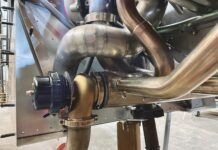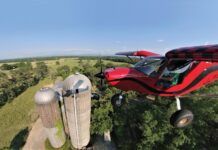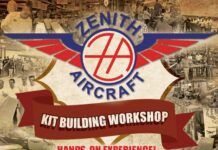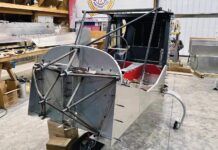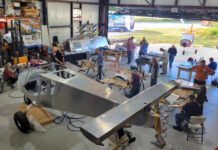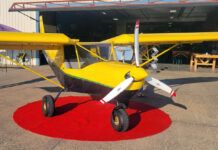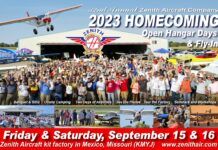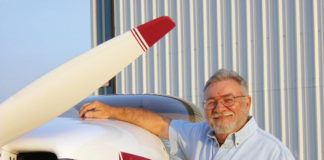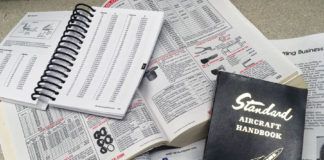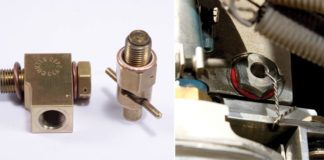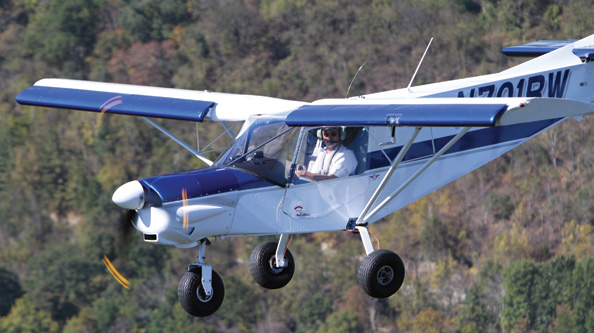
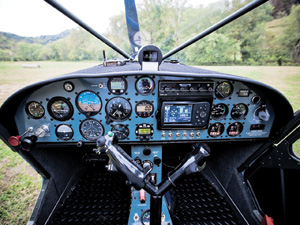
A packed panel adds weight but is the feature that attracts the most attention at the airport.
“When you’re self-employed and have kids, it’s hard to afford to fly,” said Wayne Clagg. His company, Wayne’s Heating & Air Conditioning, Inc., has served Milton, West Virginia’s population of 2200 and the adjacent communities since 1986. A private pilot since 1992, Clagg has flown off and on as time and money allowed, but he didn’t want the family to sacrifice for something that was just for him.
Unable to remember when he wasn’t interested in airplanes, Clagg started flying lessons in 1986. Thirty-six hours into his pilot training, the man he worked for died, and Wayne, just 22, bought the business. Flying would have to wait while he built the business and a family. “I like to tell everyone that I bought my wife, Donna, with the company,” he says, laughing. She started two weeks before he did, and she stayed when he took over. “We developed a good relationship and got married in 1990,” he says, and had their daughter Susan, who last fall started at Marshall University in Huntington, 20 miles to the east. Clagg also has two grown stepkids, Timmy, who lives in Tennessee, and Lisa, who works in Clagg’s office.
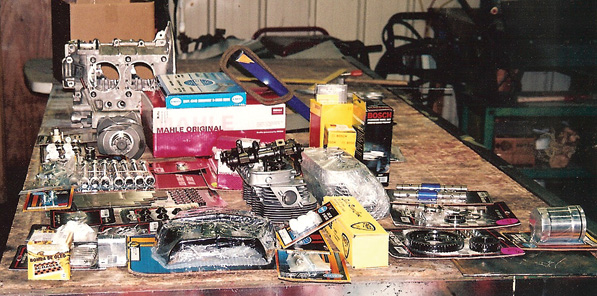
All of the components for the first Volkswagen engine.
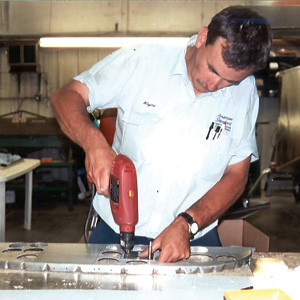
Hand-drilling the panel using a borrowed instrument panel punch took one evening.
When it comes to flying, the family “can take it or leave it,” Clagg said. But his wife and daughter are big into horses, and the family owns a farm in Lincoln County, near to where Chuck Yeager hails from. Covering 50 hilly acres at the end of a two-turn valley approach, the farm had a level area perfect for a 1300-foot grass strip—land to the south and take off to the north.
Clagg was desperate to have his own airplane. Sitting on the porch one evening in 2005, Clagg told his wife, “I really miss flying, and I’d like to get an ultralight or something to keep here at the farm.” He explained that building it himself would make it affordable, and she thought it was a good idea.
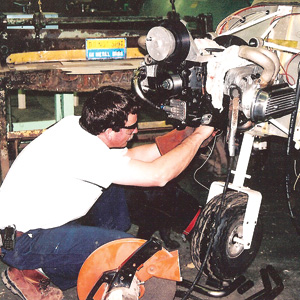
Getting a plan together for the exhaust system. You can see the homebuilt engine mount and the Valley Engineering redrive here.
Returning to the magazine he was reading, he found his airplane. “So help me God,” Wayne said, “I was reading KITPLANES, and on the inside back cover was the advertisement for Zenith’s STOL CH 701.” Its short takeoff and landing capabilities were perfect for the farm. “It had tricycle gear, so I didn’t need a tailwheel endorsement, and it was all metal,” he said. “Being a heat and air conditioning guy, that’s right up my alley.”
Research revealed that the Zenith would accept a VW engine, another cost savings, and it could be built from plans. And that’s what Clagg did, in 23 months, for less than $23,000. A thousand of that was freight, $7000 was engine, and the rest of it was airframe. He started construction in October 2006 and made the first flight on November 3, 2008.
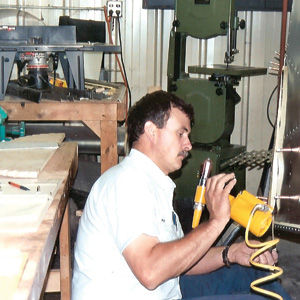
Eye of the Beholder
At first Clagg thought that it was “one of the ugliest airplanes ever made.” But he quickly appreciated the beauty of form following function. Introduced in 1986, the CH 701 was specifically designed by Chris Heintz for off-airport STOL. Fixed leading-edge slats and full-span flaperons deliver slow flight, while the all-flying rudder points the way. The design had the wings attached above the fuselage and their roots tapered for the optimum field of view. To keep the tricycle gear short, the steeply tapered tail cone parallels the angle of attack that quickly launches the 701.
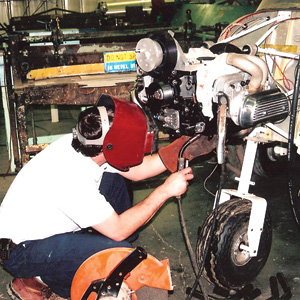
Tack-welding the scratch-built exhaust system. Clagg made almost every part of the plane.
Zenith Aircraft has sold about a thousand CH 701 kits worldwide, says Sebastien Heintz, who now runs the company. Roughly 700 are flying, with a couple hundred of them in the U.S. It’s not possible to say how many have been built from the thousands of plans sold because scratch-building is a relative term. Some people build everything, others build some assemblies and buy ready-made parts they don’t have the desire, tools or skills to fabricate.
Building from plans is not automatically less expensive, says Heintz. “As a rule of thumb, materials are half the kit price.” In round numbers for the 701, that’s $7000. As with a kit, that doesn’t include the engine, paint, instruments or avionics. Nor does it include tools, which can be a substantial investment for scratch-builders whose shop does not include sheet-metal fabrication equipment such as shears and bending brakes.
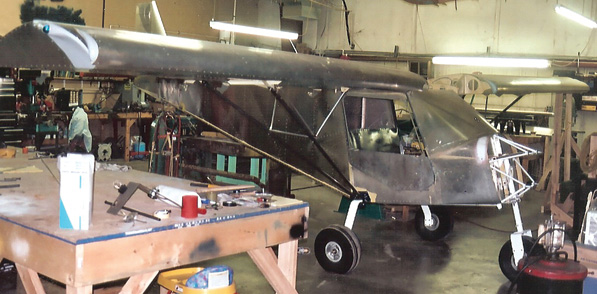
Fourteen months of work resulted in this finished product. Clagg completely assembled the airplane and then took it back apart for paint. At this point the project was the most satisfying thing he had ever done.
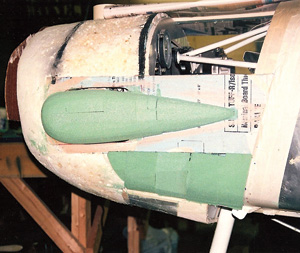
Building up the cowling plug using spray foam, sheet foam insulation and floral foam. The engine is in that mess somewhere. This was the hardest part of the project and nearly brought the build to an end.
Then there’s the learning curve. Given the 701’s backcountry mission, “We’ve tried to keep everything as simple as possible,” Heintz said. Still, first-time scratch-builders incur do-over costs because they often build a part several times before getting it right. With its CNC cut, drilled and formed parts, the 701 kit takes 400 to 500 hours to assemble, but a plug-and-play engine and instrument package can be installed in a couple of weekends. The time required to build a 701 from plans? Depends on the craftsman.
Building Serendipity
Little did Clagg know that his decision to pursue heating and air conditioning would prepare him to scratch-build a CH 701. He was going to be an electrician, but on his first day at the Cabell County Career Technical Center he decided it wasn’t for him, citing the instructor’s personal math prerequisites. “Heating and air conditioning was one of three things they had openings for,” he said. “I had a friend in that class, and the rest is history.”
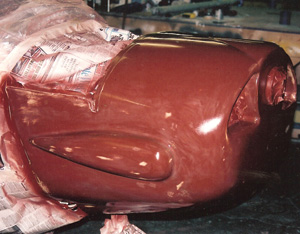
The finished and waxed plug just minutes before the first layup of glass. This is the second plug made; the first did not have the proper look. Clagg doubts the plane would have been finished if not for the help of friend Billy Rose on the cowling.
About 15 years ago Wayne’s Heating & Air Conditioning bought a 50×60-foot shop on Main Street in Milton. It’s home to all of the tools needed for the sheet-metal-intensive trade, including 4- and 10-foot bending brakes, a stomp shear, lathe and milling machine. The only tools he needed for the 701 were items such as Clecoes and Cleco pliers.
As he would for any job, Clagg compiled a detailed materials list and sent a request-for-quote to the well-known suppliers of homebuilding materials. Wicks Aircraft Supply had the winning bid, so he ordered everything at once for a total of $2300. When the truck arrived, he slid the skid into his shop and started work.
No stranger to blueprints, Clagg said the binder of 11×17-inch CAD drawings still temporarily overwhelmed him. At first all of the detailed lines and text “look like spaghetti.” The feeling that he’d made a mistake dissipated as he studied them and realized that there was really nothing to it, so he started on Page 1. When he’d fabricated those parts, he turned the page, and kept working and turning until he was done.
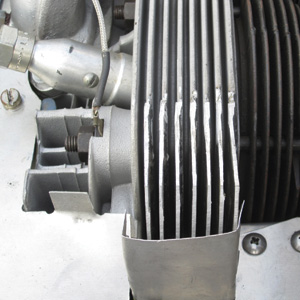
The right cylinder head with the trial or developmental first generation fin extensions. Testing proved the fins were too large, and they were reduced in size and number on the second generation heads Clagg currently flies.
Except for the AN hardware, the plans use the metric system. “I don’t know why you’d want to build an airplane any other way,” Clagg said. “I went to Lowe’s and bought a couple of rulers marked off in millimeters and inches,” and then he did all of the simple math, such as dividing a given length for even rivet spacing, on a calculator. Doing that in inches involves fractions, which he said “just looks pregnant with mistakes.”
Construction progressed rapidly. “I’d get up every morning, walk across the driveway [to the shop], and work on it for an hour or two before I’d go out on service calls,” Clagg said. “If I had any spare time during the day, it was right there.”
With the milling machine he quickly cut every lightening hole in the airplane. In three evenings on the lathe, he turned three different sized flanging dies and then flanged every lightening hole on the fourth. “Going all the way around with a [hand] flanging tool can take 20 minutes a rib,” Clagg said. But it takes no time at all to “put the rib in the die and whang it with a hammer. If you’re careful, you can do all the ribs in 20 minutes.”
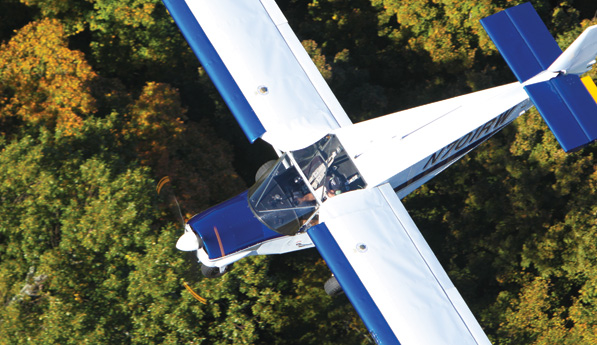
Low and slow in the bush of West Virginia, enjoying the early fall colors. This is where the 701 is at home and is the type of flying Clagg enjoys the most.
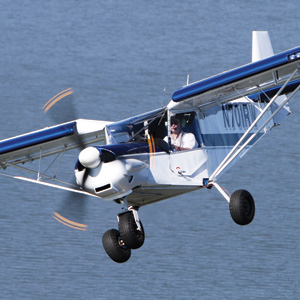
A good view of the scratch-built cowling and 68-inch Powerfin three-blade prop. The oil cooler intake is on the bottom, and the NACA ducts are no longer functional.
A few parts would have cost him more to make than to buy, so he ordered the windshield, main landing gear spring, nosegear fork and doubler, and the rear spar fuselage carry-through from Zenith. Sticking closely to the plans, mostly, Clagg did made a few modifications. “I put landing lights in the left slat, electric flaps and built a center console to rest my leg against.”
For outside help Clagg turned to John Croke of HomebuiltHelp.com. Loading the 701 construction videos on his laptop, he watched the applicable segment in the shop before starting work. He called on the factory once, emailing a photo of the spar with a hole improperly drilled and a question. “So I’ve got a wingspar in my bone yard, and I learned my lesson to never ignore the old saying to measure twice and cut—or drill—once.”
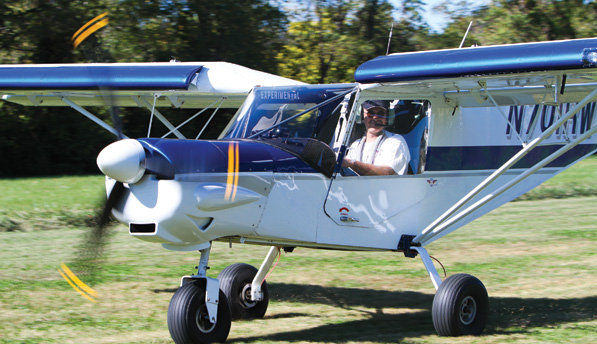
The smile absolutely says it all. After a few engine and prop changes the performance is much better. Climb is 750 fpm, cruise is 90 mph with CHTs around 270. Reliability has improved enough that Clagg routinely flies to local airports and fly-ins.
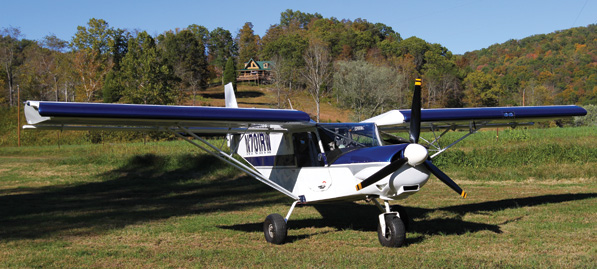
N701RW at its home base, Crazy Horse International, with the “control tower” in the background. Clagg was sitting on the porch when the decision was made to build the 701.
In 14 months the airframe was done, complete with a full IFR panel, courtesy of his first homebuilt project, a WAR F4U Corsair he started in the 1980s. By 1986 the Corsair was ready for an engine and covering, which never happened. Years later, after watching videos of people landing the wood-and-foam warbird, Clagg decided, “I don’t need to fly that bad.” The Corsair hung from the shop ceiling until 2007, when he sold it for $1200, which paid for the 701’s propeller.
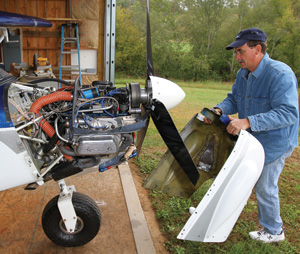
Removing the cowling for a routine maintenance check and oil change takes a few minutes. The engine makes about 102 horsepower at full power, and Clagg cruises at 3900 engine rpm and approximately 85 hp.
A careful accountant, he included this in the 701’s ledger, and he added the receipts for the Corsair’s instruments and Cleveland brakes, disks and cylinders that also went into the 701. He did the same for Christmas gifts, items such as engine instruments and the four-point racing harnesses (which he says were less expensive than the factory seat belts).
Power Struggle
It took Clagg nine months to complete work forward of the firewall, with the hand-laid (and heavy) fiberglass cowling accounting for four of those. “What’s duck soup for one guy is a real back breaker for another,” he explained. As for the VW engine it covers, he’s still testing a fat-fin modification he hopes will solve its hotheadedness and keep him flying until he saves up enough for a Rotax 912S.
“The VW has its place in aviation; the Sonex and other planes prove that,” Clagg said. “But based on my experience, the 701 isn’t one of them.” Keeping the engine cool is one problem, and weight is the other. His CH 701 weighs 742 pounds empty. The engine, complete with baffling, alternator, vacuum pump, Ellison injector and dual ignition (12-volt and Slick mag), weighs 223 pounds.
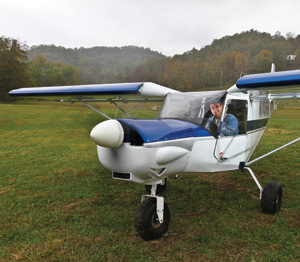
Clagg used the knowledge gained from the original fat-fin experiment to build another set of heads. He can now maintain full power indefinitely with cylinder-head temperatures of around 300.
Drawing on his past VW racing experience, Clagg had hoped to develop a cheap, reliable powerplant with mass appeal. With a local source of high-performance parts, he wouldn’t have to pay freight, and he believed he could overcome any problems. Putting 90 hours on it in less than two years, he has overcome problems for the most part, but, “Sometimes, you know, you’re just not too smart,” he said.
Built with testing in mind, every cylinder’s CHT and EGT are measured. “Most of my problems are heat related, just like everybody told me,” Clagg said, but others were beyond his control. Building the engine himself, he questioned the machining that opened up the crankcase for the 94mm barrels, but the parts shop said all was well. Almost immediately the CHTs climbed to 400 F or more and the heads started leaking, so he redesigned the cooling system.
It’s All in Your Heads
At 60 hours, he tuned the engine in preparation for his fly-in debut at Zenith’s September open hangar event in Mexico, Missouri. The bottom spark plugs pulled out all of the threads, and Clagg, devastated, took a couple of months off from the project. Pulling the heads revealed leaks, which he attributed to heat, so he invested $1000 in new heads from Great Plains Aircraft Supply. Within two hours they had leaking exhaust valves. Great Plains and the local shop diagnosed tight valve guides. “The weather had turned cold, and that was making the valves leak,” Clagg said. “Of course, when the engine warmed up, the valves would seal. I’m no expert, but that doesn’t sound right.”
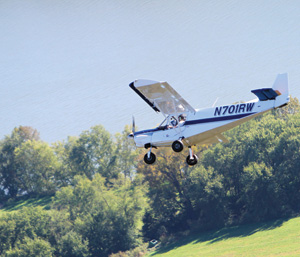
Diving away for a “strafing run” on an unsuspecting adversary on the Ohio River. Flight testing throughout the summer of 2010 improved Clagg’s confidence in the VW engine.
With 14 hours on the new heads, the engine wimped out as Clagg was heading to the farm. “Again I went through this whole depression thing,” he said. When he finally removed the heads, they were leaking just like the originals.
It turned out that the sealing surfaces machined on the case were slightly off, so the 94mm cylinders were splayed like a Y, a problem the local shop fixed. While continuing to save up for a Rotax, he was going to give up flying, “But I got bored last winter,” he said.
He had been talking to Bob Hoover of fat-fin fame, and then he found Durafix, a new material that would allow him to attach the cooling fin extensions to the repaired original heads without a TIG welder. “I couldn’t believe the difference,” Clagg said. It lowered the CHT 100 in climb and 80 in cruise. Fat-fin testing went well until the 11.5-hour mark, logged last May, the airplane’s last flight as of summer 2010. Tracking down the vibration born on that flight revealed leaking exhaust valves and a cracked head.
While the fat fins seem to control temperatures, Clagg characterizes the 701’s VW performance as “not great.” Taking off solo, with full fuel and a 2000-foot density altitude, the 701 climbs at 500 fpm. With a Rotax, the book says it’ll climb at 1200 fpm. The VW’s 85-mph cruise won’t change, and fuel consumption is similar to the VW’s 5.8 gph, but the Rotax is about 100 pounds lighter.
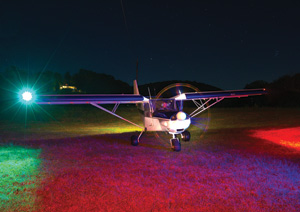
Closing out the day with a landing at home in your very own scratch-built plane. What more could you ask for?
Despite the power struggle, Clagg loves the way the 701 flies. “It just seems to follow your mind,” he said. Landing, on the other hand, is an acquired skill he started learning at the factory before his first flight. Carrying a little power gives the tail the authority it needs to flare, which is great for spot landings. “When you get to where you want the mains to touch down, you just jerk the juice out of it and it’ll touch down,” he said.
Until the weather breaks and the service calls subside a bit, the 701 waits patiently in its hangar at the farm. There is some solace in that, because it means the intervals between off-and-on flying are much shorter than they were before Clagg built his own airplane.
For more information on Zenith Aircraft, call 573/581-9000 or visit www.zenithair.com.



